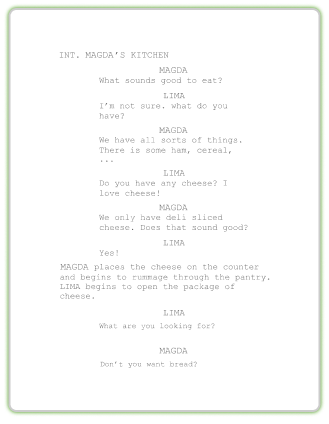With one click
Export a perfectly formatted traditional script.
"Ideally, every scene is a story event."
How do you structure great scenes? Each scene should tell its own story, reveal the characters' values, and move the plot forward. If it doesn't, you should trash it. At least, that's the wisdom shared by award-winning screenwriter, journalist, author, and podcaster Bryan Young (SyFy.com, StarWars.com, /Film, HowStuffWorks.com) and screenwriting guru Robert McKee.
Export a perfectly formatted traditional script.


We interviewed Bryan on the topic of writing great scenes and sequences in your screenplay, and he said it comes down to two elements: positive and negative charges.
"As far as developing scenes and sequences, I would look back to Robert McKee's work, especially in his book, "Story," [and] his theory on the positive or negative charges of scenes," Bryan explained. "If you're having a problem with your scene progression or your scene development, make sure that you're entering a scene on one charge and that you're exiting the scene on a different charge."
That means that the scene needs to turn and needs to act as its own movie within the movie. A scene has to present some conflict, whether that's within the character, an obstacle in the character's way, or a value at stake for the protagonist – whether that's truth, love, or something else.
"I use "Star Wars" as an example for this a lot," Bryan began. "Luke Skywalker is really excited and eager about these droids. Then as the scene ends, it ends on a negative charge because his uncle says, "No, you can't go hang out with your friends or get off the farm. You've got to go clean these droids."
Luke's uncle is standing in the way of him and his adventure.
"When we enter the next scene with Luke, we start on that negative charge. He's playing with his toys. He's dejected," Bryan explained.
But then, everything changes.
"He gets excited because he sees this message from the princess. The scene ends on a positive charge because he's so excited at the prospect of this adventure."
And this continues.
"It takes this rollercoaster of these alternating charges on the scenes."
If a scene does not feature an opposite charge at the beginning and the end, you have to ask yourself what purpose it serves in your screenplay. As McKee explains in "Story," often writers will say that the scene serves as some exposition for the screenplay, whether that's location, current events, or background, but a great writer will weave that exposition in elsewhere. It should not take up an entire scene. "If you can chart out in your screenplay the positive and negative charges of your scenes, your screenplay is not going to have any monotony to it," Bryan concluded. "It's going to have constant, dynamic changes, [and] that's going to make your screenplay sing, and it's going to make it so that people reading it are going to want to turn pages to find out what happens next."
That's what we're aiming for. A real page-turner,